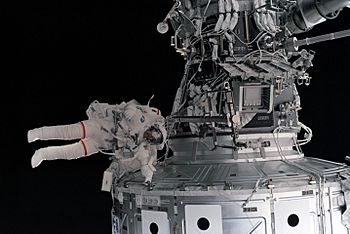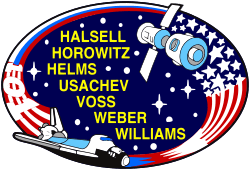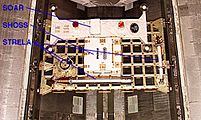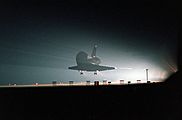STS-101 facts for kids

Williams outside Unity during the mission's sole EVA
|
|
| Mission type | ISS assembly/logistics |
|---|---|
| Operator | NASA |
| Mission duration | 9 days, 21 hours, 10 minutes, 10 seconds |
| Distance travelled | 6.6 million kilometres (4.1 million miles) |
| Orbits completed | 155 |
| Spacecraft properties | |
| Spacecraft | Space Shuttle Atlantis |
| Landing mass | 100,369 kilograms (221,276 lb) |
| Payload mass | 1,801 kilograms (3,971 lb) |
| Crew | |
| Crew size | 7 |
| Members |
|
| EVAs | 1 |
| EVA duration | 6 hours, 44 minutes |
| Start of mission | |
| Launch date | 19 May 2000, 10:11 UTC |
| Launch site | Kennedy LC-39A |
| End of mission | |
| Landing date | 29 May 2000, 06:20 UTC |
| Landing site | Kennedy SLF Runway 15 |
| Orbital parameters | |
| Reference system | Geocentric |
| Regime | Low Earth |
| Perigee | 319 kilometres (198 mi) |
| Apogee | 332 kilometres (206 mi) |
| Inclination | 51.5 degrees |
| Period | 91.04 minutes |
| Epoch | 21 May 2000 |
| Docking with ISS | |
| Docking port | PMA-2 Unity forward |
| Docking date | 21 May 2000, 04:31 UTC |
| Undocking date | 26 May 2000, 23:03 UTC |
| Time docked | 5 days, 18 hours, 32 minutes |
  STS-101 crew (left to right): Weber, Williams, Horowitz, Usachov, Voss (in white suit), Halsell, Helms |
|
STS-101 was a Space Shuttle mission to the International Space Station (ISS). The mission was flown by the Space Shuttle Atlantis from May 19 to May 29, 2000. This 10-day journey was important for bringing supplies to the ISS, which was still being built at the time.
The STS-101 mission was delayed three times in April because of strong winds. During its flight, Atlantis traveled 4.1 million miles and orbited Earth 155 times. It landed safely at the Kennedy Space Center in Florida. This mission was also special because it was the first time a Space Shuttle flew with a new "glass cockpit," which uses computer screens instead of many traditional dials and gauges.
Contents
Meet the Astronauts: STS-101 Crew
The STS-101 mission had a crew of seven brave astronauts. They were responsible for flying the Space Shuttle and completing all the tasks needed for the International Space Station.
| Position | Astronaut | |
|---|---|---|
| Commander | Fifth and last spaceflight |
|
| Pilot | Third spaceflight |
|
| Mission Specialist 1 | Second and last spaceflight |
|
| Mission Specialist 2 | First spaceflight |
|
| Mission Specialist 3 | Fourth spaceflight |
|
| Mission Specialist 4 | Fourth spaceflight |
|
| Mission Specialist 5 | Third spaceflight |
|
Spacewalks: Working Outside the Station
During the STS-101 mission, two astronauts, James Voss and Jeffrey Williams, performed a spacewalk. This was a very important part of the mission.
- The spacewalk, called EVA 1, started on May 22, 2000, at 01:48 UTC.
- It ended on May 22, 2000, at 08:32 UTC.
- The spacewalk lasted for 6 hours and 44 minutes.
Key Goals of the Mission
The STS-101 mission had several important goals to help build and prepare the International Space Station. It was originally planned to happen after another module, Zvezda, arrived. But when Zvezda was delayed, STS-101 was split into two parts. The astronauts on this mission, including some who would later be part of Expedition 2 on the ISS, helped get the station ready for future crews.
Delivering Supplies and Equipment
The Space Shuttle Atlantis carried many important items to the ISS. These supplies were stored in a special module called a Spacehab and on an Integrated Cargo Carrier pallet.
- Air and Safety Checks: Astronauts took air samples, checked carbon dioxide levels, and replaced air filters. They also replaced fire extinguishers and smoke detectors in the Zarya module.
- Repairs and Replacements: They fixed or replaced four batteries on Zarya and other electronic parts. They also replaced a memory unit for the Radio Telemetry System and an antenna.
- Assembly and Upgrades: The crew helped put together parts of the Strela crane, which is used to move things outside the station. They also installed more handrails and set up cables for cameras.
- General Supplies: The mission also brought water, office supplies, personal items for astronauts, and equipment for exercise and medical support.
Boosting the Station's Orbit
One key task was to "reboost" the International Space Station. This means pushing it to a higher orbit. The crew raised the station's altitude from about 230 miles (370 km) to 250 miles (400 km). This is important because the station slowly loses altitude over time due to tiny amounts of drag from Earth's atmosphere.
A Close Call: Tile Damage
During the mission, there was a serious issue with a damaged heat shield tile on the Space Shuttle Atlantis. This damage allowed superheated gas to enter the left wing during its return to Earth. Luckily, the gas did not go too deep, and the damage was fixed before the next flight. This incident showed how important it is to check every part of the Shuttle for safety.
New Technology: The Glass Cockpit
STS-101 was the first Space Shuttle mission to fly with a "glass cockpit". This is a modern flight deck that uses computer screens to display information, rather than many separate dials and gauges. It makes it easier for astronauts to see and understand important flight data.
Wake-up Calls: Music in Space
NASA has a fun tradition of playing music to wake up astronauts in space. This started during the Gemini program and was first used to wake up a crew during the Apollo 15 mission. Each song is chosen carefully, often by the astronauts' families. The music usually has a special meaning to an astronaut or relates to their daily tasks in space.
| Flight Day | Song | Artist | Played for | Links |
|---|---|---|---|---|
| Day 2 | "Free Fallin" | Tom Petty | Susan Helms | wav, mp3 Transcript |
| Day 3 | "Lookin' Out The Window" | Stevie Ray Vaughan | wav, mp3 Transcript |
|
| Day 4 | "Haunted House" | Roy Buchanan | wav, mp3 Transcript |
|
| Day 5 | "I Only Have Eyes for You" | Flamingos | Jim Halsell | wav, mp3 Transcript |
| Day 6 | "I'm Gonna Fly" | Amy Grant | Scott Horowitz | wav, mp3 Transcript |
| Day 7 | "Don't It Make You Wanna Dance" | Jerry Jeff Walker | Jeffrey Williams | wav, mp3 Transcript |
| Day 8 | Untitled Russian song | Unknown | Yury Usachov | wav, mp3 Transcript |
| Day 9 | "25 or 6 to 4" | Chicago | wav, mp3 Transcript |
|
| Day 10 | "El Capitan" | John Philip Sousa | wav, mp3 Transcript |
Images for kids
See also
 In Spanish: STS-101 para niños
In Spanish: STS-101 para niños







